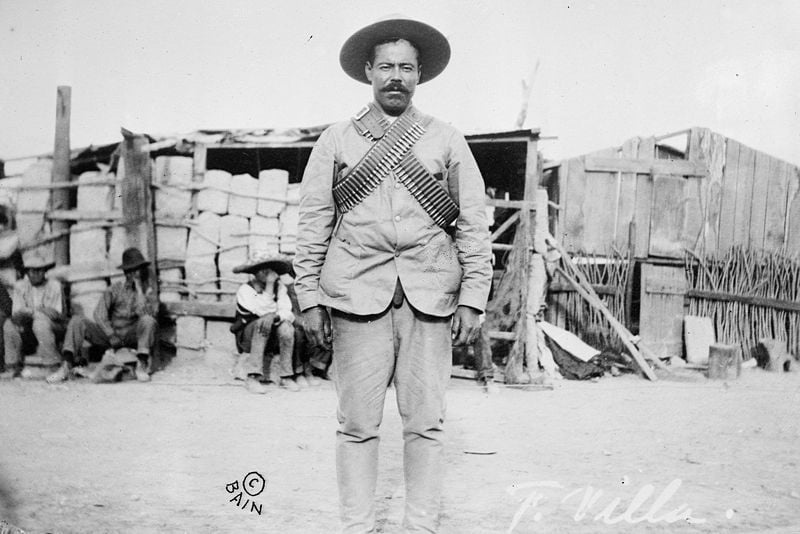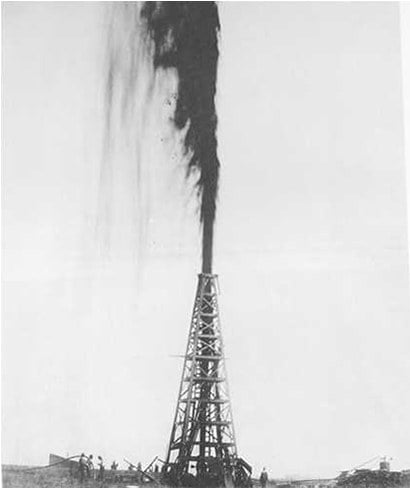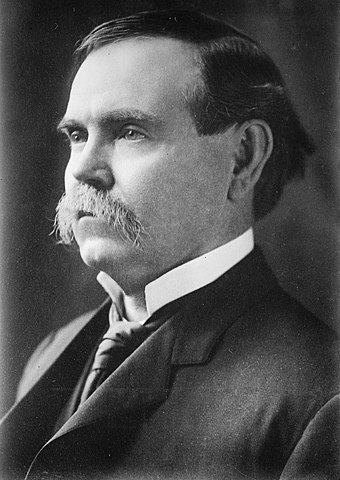One of the greatest natural disasters ever to strike the state occurred on Sept. 8, 1900, when a hurricane devastated Galveston, killing 6,000 people. (Read more about the hurricane here.) In rebuilding from that disaster, Galveston's civic leaders fashioned the commission form of municipal government. Amarillo later refined the system into the council-manager organization that is widely used today.
The great Galveston storm also reinforced arguments by Houston's leadership that an inland port should be built for protection against such tragedies and disruptions of trade. The Houston Ship Channel was soon a reality.
Seldom can a people’s history be profoundly changed by a single event on a single day. But Texas' entrance into the industrial age can be linked directly to the discovery of oil at Spindletop, three miles from Beaumont, on Jan. 10, 1901. From that day, Texas' progress from a rural, agricultural state to a modern industrial giant was steady.
The reform spirit in government was not dead after the departure of Jim Hogg. In 1901, the Legislature prohibited the issuing of railroad passes to public officials. More than 270,000 passes were issued to officials that year, and farmers claimed that the free rides increased their freight rates and influenced public policy as well.
In 1903, state Sen. A.W. Terrell got a major election-reform law approved, a measure that was further modified two years later. A primary system was established to replace a hodgepodge of practices for nominating candidates that had led to charges of irregularities after each election.
Also in the reform spirit, the Legislature in 1903 prohibited abuse of child labor and set minimum ages at which children could work in certain industries. The action preceded federal child-labor laws by 13 years.
However, the state, for the first time, imposed the poll tax as a requirement for voting. Historians differ on whether the levy was designed to keep blacks or poor whites — or both — from voting. Certainly the poll tax cut election turnouts. Black voter participation dropped from about 100,000 in the 1890s to an estimated 5,000 in 1906.
The Democratic State Executive Committee also recommended that county committees limit participation in primaries to whites only, and most accepted the suggestion.
The election of Thomas M. Campbell as governor in 1906 marked the start of a progressive period in Texas politics. Interest revived in controlling corporate influence.
Under Campbell, the state's antitrust laws were strengthened and a pure food and drug bill was passed. Life insurance companies were required to invest in Texas 75 percent of their reserves on policies in the state. Less than 1 percent of the reserves had been invested prior to the law.
Some companies left Texas. But the law was beneficial in the capital-starved economy. In 1904, voters amended the constitution to allow the state to charter banks for the first time, and this eased some of the farmers' credit problems. In 1909, the Legislature approved a bank-deposit insurance plan that predated the federal program.
With corporate influence under acceptable control, attention turned to the issue of prohibition of alcohol. Progressives and prohibitionists joined forces against the conservative establishment to exert a major influence in state government for the next two decades.
Prohibition
Prohibitionists had long been active in Texas. They had the local-option clause written into the Constitution of 1876, which allowed counties or their subdivisions to be voted dry. But in 1887, a prohibition amendment to the state constitution had been defeated by a 2-to-1 margin, and public attention had turned to other problems.
In the early 20th century, the prohibition movement gathered strength. Most of Texas already was dry because of local option. When voters rejected a prohibition amendment by a slim margin in 1911, the state had 167 dry counties and 82 wet or partially wet counties. The heavily populated counties, however, were wet. Prohibition continued to be a major issue.
Problems along the U.S.-Mexico border escalated in 1911 as the decade-long Mexican Revolution broke out. Soon the revolutionaries controlled some northern Mexican states, including Chihuahua. Juarez and El Paso were major contact points. El Paso residents could stand on rooftops to observe the fighting between revolutionaries and government troops. Some Americans were killed.
After pleas to the federal government got no action, Gov. Oscar Colquitt sent state militia and Texas Rangers into the Lower Rio Grande Valley in 1913 to protect Texans after Matamoros fell to the rebels. Unfortunately, the Rangers killed many innocent Mexican-Texans during the operation. In addition to problems caused by the fighting and raids, thousands of Mexican refugees flooded Texas border towns to escape the violence of the revolution.
In 1914, James E. Ferguson entered Texas politics and for the next three decades, “Farmer Jim” was one of the most dominating and colorful figures on the political stage. Ferguson, a banker from Temple, skirted the prohibition issue by pledging to veto any legislation pertaining to alcoholic beverages. His strength was among farmers, however. Sixtytwo percent of Texas' farmers were tenants, and Ferguson pledged to back legislation to limit tenant rents. Ferguson also was a dynamic orator. He easily won the primary and beat out three opponents in the general election.
Ferguson's first administration was successful. The Legislature passed the law limiting tenants' rents, although it was poorly enforced, and aid to rural schools was improved.
In 1915, the border problems heated up. A Mexican national was arrested in the Lower Rio Grande Valley carrying a document outlining plans for Mexican- Americans, Indians, Japanese, and blacks in Texas and the Southwest to eliminate all Anglo males over age 16 and create a new republic. The document, whose author was never determined, started a bloodbath in the Valley. Mexican soldiers participated in raids across the Rio Grande, and Gov. Ferguson sent in the Texas Rangers.
Historians differ on the number of people who were killed, but a safe assessment would be hundreds. Gov. Ferguson and Mexican President Venustiano Carranza met at Nuevo Laredo in November 1915 in an attempt to improve relations. The raids continued.
Pancho Villa raided Columbus, N.M., in early 1916; two small Texas villages in the Big Bend, Glenn Springs and Boquillas, also were attacked. In July, President Woodrow Wilson determined that the hostilities were critical and activated the National Guard. Soon 100,000 U.S. troops were stationed along the border. Fort Bliss in El Paso housed 60,000 men, and Fort Duncan near Eagle Pass was home to 16,000.
With the exception of Gen. John J. Pershing's pursuit of Villa into Northern Mexico, few U.S. troops crossed into Mexico. But the service along the border gave soldiers basic training that was put to use when the United States entered World War I in 1917. Ferguson was easily re-elected in 1916, and he worked well with the Legislature the following year. But after the Legislature adjourned, the governor got into a dispute with the board of regents of the University of Texas. The disagreement culminated in the governor's vetoing all appropriations for the school. As the controversy swirled, a Travis County grand jury indicted Ferguson for misappropriation of funds and for embezzlement. In July 1917, Speaker of the Texas House F.O. Fuller called a special session of the Legislature to consider impeachment of the governor.
The Texas House voted 21 articles of impeachment, and the Senate in August 1917 convicted Ferguson on 10 of the charges. The Senate's judgment not only removed Ferguson from office, but also barred him from seeking office again. Ferguson resigned the day before the Senate rendered the decision in an attempt to avoid the prohibition against seeking further office.
Texas participated actively in World War I. Almost 200,000 young Texans, including 31,000 blacks, volunteered for military service, and 450 Texas women served in the nurses' corps. Five thousand lost their lives overseas, either fighting or in the influenza pandemic that swept the globe.
Texas also was a major training ground during the conflict, with 250,000 soldiers getting basic training in the state. On the negative side, the war frenzy opened a period of intolerance and nativism in the state. German- Texans were suspect because of their ancestry. A law was passed to prohibit speaking against the war effort. Persons who failed to participate in patriotic activities often were punished. Gov. William P. Hobby even vetoed the appropriation for the German department at the University of Texas.
Ferguson's removal from office was a devastating blow to the anti-prohibitionists. Word that the former governor had received a $156,000 loan from members of the brewers' association while in office provided ammunition for the progressives. In February 1918, a special session of the Legislature prohibited saloons within a 10-mile radius of military posts and ratified the national prohibition amendment, which had been introduced in Congress by Texas Sen. Morris Sheppard.
Women also were given the right to vote in state primaries at the same session.
Although national prohibition was to become effective in early 1920, the Legislature presented a prohibition amendment to voters in May 1919, and it was approved, bringing prohibition to Texas earlier than to the rest of the nation. At the same time, a woman suffrage amendment, which would have granted women the right to vote in all elections, was defeated.
Although World War I ended in November 1918, it brought many changes to Texas. Rising prices during the war had increased the militancy of labor unions.
Blacks also became more militant after the war. Discrimination against black soldiers led in 1917 to a riot in Houston in which several people were killed.
With the election of Mexican President Alvaro Obregón in 1920, the fighting along the border subsided. In 1919, state Rep. J.T. Canales of Brownsville initiated an investigation of the Texas Rangers' role in the border problems. As a result of the study, the Rangers' manpower was reduced from 1,000 members to 76, and stringent limitations were placed on the agency's activities. Standards for members of the force also were upgraded.
By 1920, although still a rural state, the face of Texas was changing. Nearly one-third of the population was in the cities. Pat M. Neff won the gubernatorial election of 1920, beating Sen. Joseph W. Bailey in the primary. As a former prosecuting attorney in McLennan County, Neff made law and order the major thrust of his administration. During his tenure, the state took full responsibility for developing a highway system, a gasoline tax was imposed, and a state park board was established.
In 1921, a group of West Texans threatened to form a new state because Neff vetoed the creation of a new college in their area. Two years later, Texas Technological College (now Texas Tech University) was authorized in Lubbock and opened its doors in 1925.
Although still predominantly a rural state, Texas cities were growing. In 1900, only 17 percent of the population lived in urban areas; by 1920, that figure had almost doubled to 32 percent. A discontent developed with the growth of the cities. Rural Texans had long seen cities as hotbeds of vice and immorality. Simple rural values were cherished, and it seemed that those values were threatened in a changing world. After World War I, this transition accelerated.
Continued in part 2 and part 3
— This multi-part narrative of Texas' past, from prehistoric times to 1980, is based on "A Concise History of Texas" by former Texas Almanac editor Mike Kingston. Mr. Kingston's history was published in the 1986–1987 edition of the Texas Almanac, which marked Texas' sesquicentennial. Robert Plocheck, associate editor of the Texas Almanac, edited and expanded Mr. Kingston's history.




